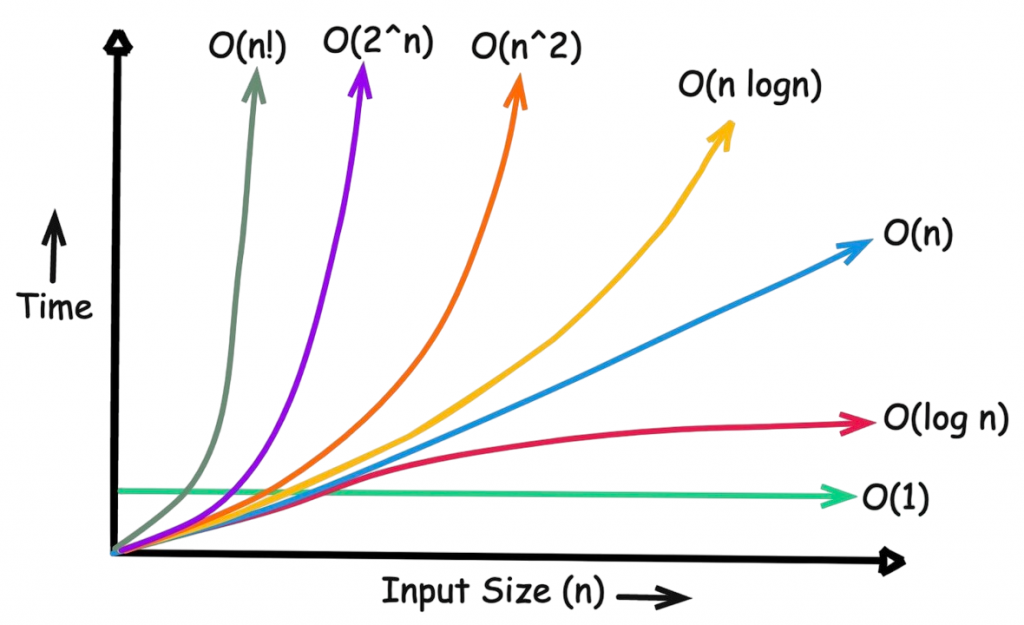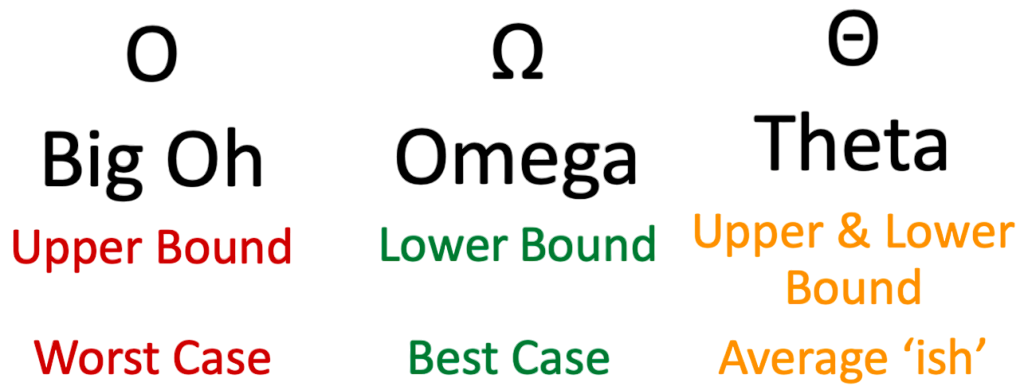
- What is Asymptotic Analysis?
- Importance in Algorithm Design
- Big O Notation
- Omega (Ω) and Theta (θ) Notations
- Comparing Growth Rates
- Best, Worst, and Average Case
- Graphical Interpretation
- Common Time Complexities
- Space Complexity Notation
- Choosing Efficient Algorithms
- Interview-Oriented Questions
- Conclusion
Asymptotic Notation in Data Structures
In computer science and data structures, analyzing the efficiency of an algorithm is critical to ensuring optimal performance, especially as the size of data increases. Asymptotic notation is a mathematical tool used to describe the performance of algorithms as input size grows towards infinity. This concept is at the heart of computational complexity theory and is crucial for comparing algorithms, predicting scalability, and making performance-conscious decisions in both academics and industry. To complement such analytical depth with practical front-end development skills, exploring Web Developer Training equips learners to build responsive, visually engaging websites using HTML, CSS, JavaScript, and modern UI frameworks bridging theoretical insight with hands-on design expertise. Let’s delve into the key concepts, notations, interpretations, and practical applications of asymptotic analysis.
To Earn Your Web Developer Certification, Gain Insights From Leading Web Developer Experts And Advance Your Career With ACTE’s Web Developer Courses Today!
What is Asymptotic Analysis?
Asymptotic analysis is the process of describing the behavior of an algorithm in terms of input size nn, especially when nn becomes very large. Rather than focusing on actual execution times, asymptotic analysis gives a generalized view of how the algorithm performs by counting fundamental operations and expressing the result in terms of input size. This helps eliminate hardware dependencies and programming language biases. The primary goal of asymptotic analysis is to determine the time or space complexity of an algorithm in a standardized, machine-independent way. To complement such analytical rigor with runtime flexibility, exploring Dynamic Method Dispatch reveals how Java resolves overridden method calls at runtime enabling polymorphic behavior that adapts to the actual object type, not just the reference type, and supports scalable, object-oriented design. It enables the developer to anticipate performance bottlenecks and design scalable algorithms by understanding their long-term behavior. While actual run-times vary depending on system specifications and compiler optimizations, asymptotic analysis remains a theoretical benchmark for algorithmic efficiency.
Importance in Algorithm Design
- Asymptotic notation plays a vital role by helping us select or design algorithms that perform well with larger datasets. It allows engineers and computer scientists to evaluate different solutions, forecast resource usage, and avoid algorithms that become impractical when input size increases. To complement such analytical precision with clean, readable code, exploring Kadane’s Algorithm highlights the rules and best practices for naming variables, functions, and classes in Python ensuring clarity, maintainability, and consistency across complex systems.
- For example, choosing between a bubble sort with O(n2)O(n^2) complexity and a merge sort with O(nlogn)O(n \log n) can make a dramatic difference in performance when sorting millions of elements. Similarly, in competitive programming and technical interviews, asymptotic analysis ensures you can justify your solution’s efficiency. In real-world applications like databases, search engines, or machine learning, it influences architecture decisions and software design.
- O(1): Constant time execution time does not depend on input size.
- O(log n): Logarithmic time performance improves with divide-and-conquer strategies.
- O(n): Linear time time grows proportionally with input size.
- O(n log n): Linearithmic time common in efficient sorting algorithms like mergesort and heapsort.
- O(n²): Quadratic time typical in nested loops, example bubble sort.
- O(2ⁿ): Exponential time grows rapidly, often seen in brute-force recursive solutions.
- O(n!): Factorial time extremely slow, common in exhaustive permutations or traveling salesman problem.
- Omega (Ω) Notation: Denotes the lower bound, representing the best-case scenario of an algorithm. For example, Ω(n) means the algorithm will take at least n steps in the best case. Though not always practically useful alone, it offers insight into the most favorable execution time.
- Theta (θ) Notation: Denotes the tight bound, representing both upper and lower bounds. If an algorithm has a time complexity of Θ(n log n), it means that it always takes time proportional to n log n for large input sizes. Theta is valuable when the best and worst-case complexities converge.
- Algorithm A: O(nlogn)O(n \log n).
- Algorithm B: O(n2)O(n^2).
- Best Case (Ω): Minimum number of steps needed.
- Worst Case (O): Maximum steps required.
- Average Case (commonly O): Expected number of operations over all possible inputs.
- Best case: Element is found at the first position → Ω(1)Ω(1).
- Worst case: Element not found or at last position → O(n)O(n).
- Average case: Element somewhere in the middle → O(n/2)O(n/2), simplified to O(n)O(n).
- O(1) is a flat line performance that doesn’t depend on input size.
- O(log n) curves gently upward.
- O(n) is a straight diagonal line.
- O(n²) shows a steep upward curve.
- O(2ⁿ) skyrockets rapidly.
- O(1): Accessing an array element, hash map lookups.
- O(log n): Binary search, heap operations.
- O(n): Traversing a list or array.
- O(n log n): Merge sort, quicksort (average case).
- O(n²): Bubble sort, insertion sort, matrix multiplication (naive).
- O(2ⁿ): Solving problems via recursion (e.g., subsets, traveling salesman).
- O(n!): Brute-force permutation generation.
- Merge sort requires O(n)O(n) extra space.
- Quick sort is O(logn)O(\log n) due to recursive stack calls.
- Algorithms that modify input in-place, like bubble sort, use O(1)O(1) space.
- Analyze input size and frequency.
- Consider average vs worst-case.
- Balance between time and space complexity.
- Factor in simplicity and ease of implementation.
- Test real-world performance and edge cases.
- Compare the time complexities of different sorting algorithms.
- What is the difference between O(n) and O(log n)?
- Why is Big O used instead of actual runtime?
- How does recursion affect time and space complexity?
- What’s the space complexity of a depth-first search?
- Can two algorithms with the same Big O behave differently?
- How would you optimize an algorithm with O(n²) complexity?
Would You Like to Know More About Web Developer? Sign Up For Our Web Developer Courses Now!
Big O Notation
The most commonly used asymptotic notation is Big O, which denotes the upper bound of an algorithm’s running time. It describes the worst-case scenario, where the algorithm takes the maximum number of steps relative to the input size nn. To complement such performance analysis with control flow mastery, exploring Introduction to Algorithms these constructs manage loop execution enabling developers to skip iterations, exit loops early, or insert syntactic placeholders for future logic. For example, an algorithm with time complexity O(n2)O(n^2) means the execution time increases proportionally to the square of the input size. Big O provides a conservative estimate of resource usage, ensuring the algorithm will not exceed the given limit. It is useful for evaluating scalability. Common Big O complexities include:

Understanding Big O helps in selecting data structures and algorithms that meet performance requirements.
Omega (Ω) and Theta (θ) Notations
While Big O gives an upper bound, Omega(Ω) and Theta(θ) provide additional context. To complement such analytical frameworks with foundational object-oriented principles, exploring Backtracking Programming reveals how every class in forming the root of the inheritance hierarchy and enabling consistent behavior across all Java objects.

Together, Big O, Omega, and Theta notations provide a complete picture of an algorithm’s behavior across all conditions.
Are You Interested in Learning More About Web Developer? Sign Up For Our Web Developer Courses Today!
Comparing Growth Rates
Growth rate comparison helps determine which algorithm will perform better as input size increases. Even if two algorithms seem equally fast on small inputs, their performance diverges dramatically for large inputs depending on their growth rates. To complement such analytical insights with practical front-end development skills, exploring Web Developer Training equips learners to build responsive, visually compelling websites using HTML, CSS, JavaScript, and modern UI frameworks bridging performance theory with user-focused design.
Let’s consider two algorithms:
For small nn, say 10 or 20, both might complete in milliseconds. However, as nn reaches 10,000 or more, Algorithm A remains feasible, while Algorithm B becomes significantly slower due to its quadratic growth. This principle underscores the importance of selecting algorithms based on growth rates rather than fixed benchmarks.
Best, Worst, and Average Case
Understanding an algorithm’s behavior across different scenarios is essential for robust design. Asymptotic notations help categorize performance as: To complement such analytical depth with structured execution flow, exploring Data Structure Definition in reveals how the entry point enabling modular design, controlled execution, and better debugging across scripts and imported modules.
For instance, in linear search:
When designing real-time systems or mission-critical software, worst-case analysis is prioritized. For probabilistic or heuristic applications, average-case becomes more relevant.
Graphical Interpretation
Graphing asymptotic notations offers intuitive insights. On a graph where the X-axis represents input size nn and the Y-axis shows the number of operations, each complexity class plots a distinct curve: To complement such performance visualization with object-oriented design principles, exploring Linked List In Data Structure reveals how classes can extend functionality from parent classes promoting code reuse, modularity, and hierarchical relationships that mirror real-world systems.
Such graphs help visualize scalability. When visualized, it becomes clear how linear and quadratic algorithms diverge as input grows. Tools like matplotlib in Python can help plot these curves for educational purposes.
Common Time Complexities
Here’s a quick look at commonly encountered time complexities and where they appear:
Understanding these helps in selecting algorithms and identifying inefficiencies in code during optimization.
Space Complexity Notation
In addition to time complexity, space complexity is crucial, especially in memory-limited systems like embedded devices. Space complexity describes how much extra memory an algorithm uses in terms of input size *n*. For example, analyzing how arrays, recursion, or dynamic programming solutions consume memory helps developers design more efficient systems. To understand how these principles connect with real-world backend engineering and scalable applications, explore Mastering Backend Development a comprehensive guide that explains Node.js career opportunities, backend frameworks, optimization strategies, and the skills required to build high-performance server-side applications.
Space complexity is also expressed using Big O, and optimizing for it is important in areas like mobile development, IoT, and large-scale distributed systems.
Choosing Efficient Algorithms
Efficiency is context-dependent. A theoretically faster algorithm may perform worse if input size is small or implementation is complex. For example, insertion sort can outperform merge sort for small arrays due to minimal overhead.
When choosing an algorithm:
In coding interviews, theoretical efficiency and code clarity are both judged. In production, maintainability and real-time responsiveness are prioritized.
Interview-Oriented Questions
Understanding asymptotic notation is essential in technical interviews. Common questions include: To complement such analytical depth with practical string manipulation skills, exploring Load Balancing Algorithms reveals how to divide strings based on delimiters, control the number of splits, and extract structured data efficiently making it a must-know tool for parsing input and handling textual data in Python.
Additionally, candidates are often asked to identify or improve the time complexity of given code snippets. Practicing such problems sharpens both analytical and coding skills.
Conclusion
Asymptotic notation provides a foundational framework for evaluating the efficiency of algorithms and data structures. It abstracts away the machine-specific details and focuses on how the algorithm performs as input size scales. By mastering Big O, Omega, and Theta notations, understanding different growth rates, analyzing best/worst/average cases, and considering both time and space complexity, one can write robust, scalable, and optimal code. To complement such algorithmic efficiency with front-end development skills, exploring Web Developer Training provides hands-on experience in HTML, CSS, JavaScript, and UI/UX design empowering learners to build responsive, visually engaging websites that perform well across devices and user scenarios. From academic theory to real-world applications and coding interviews, asymptotic analysis remains a pillar of computer science.





